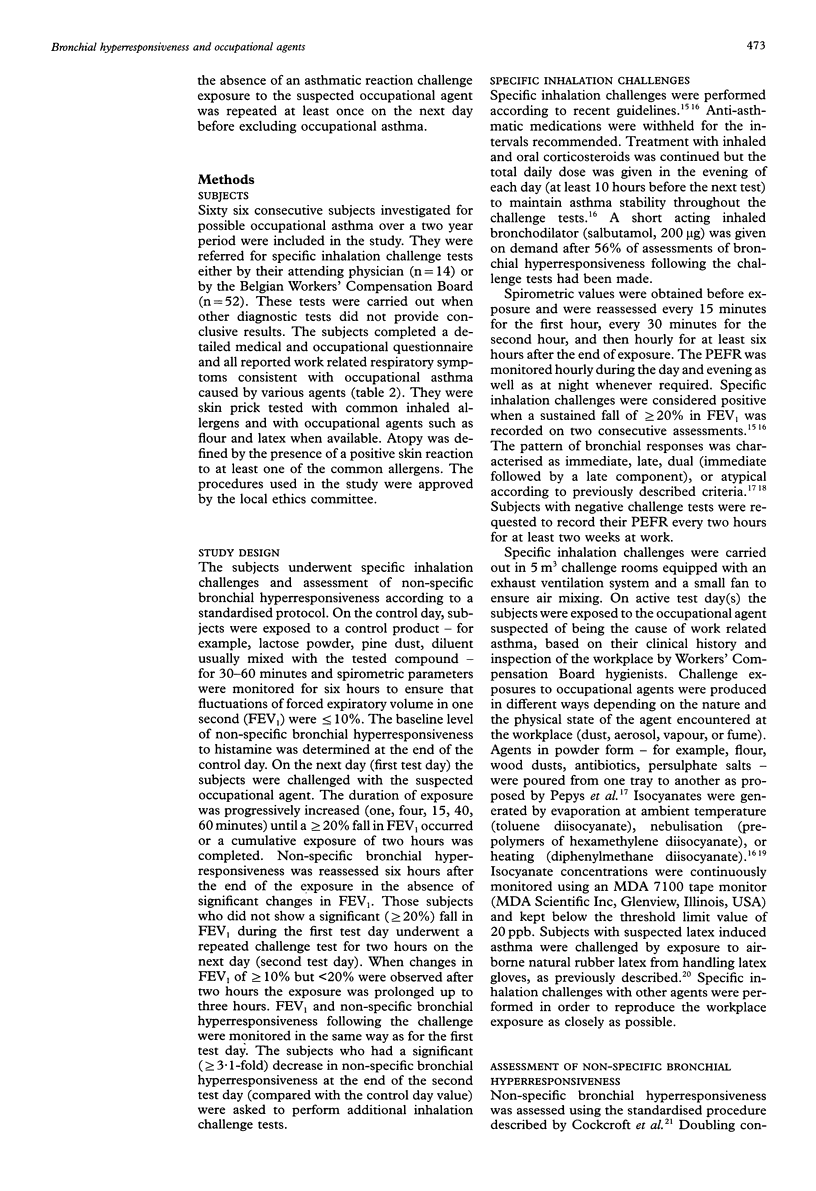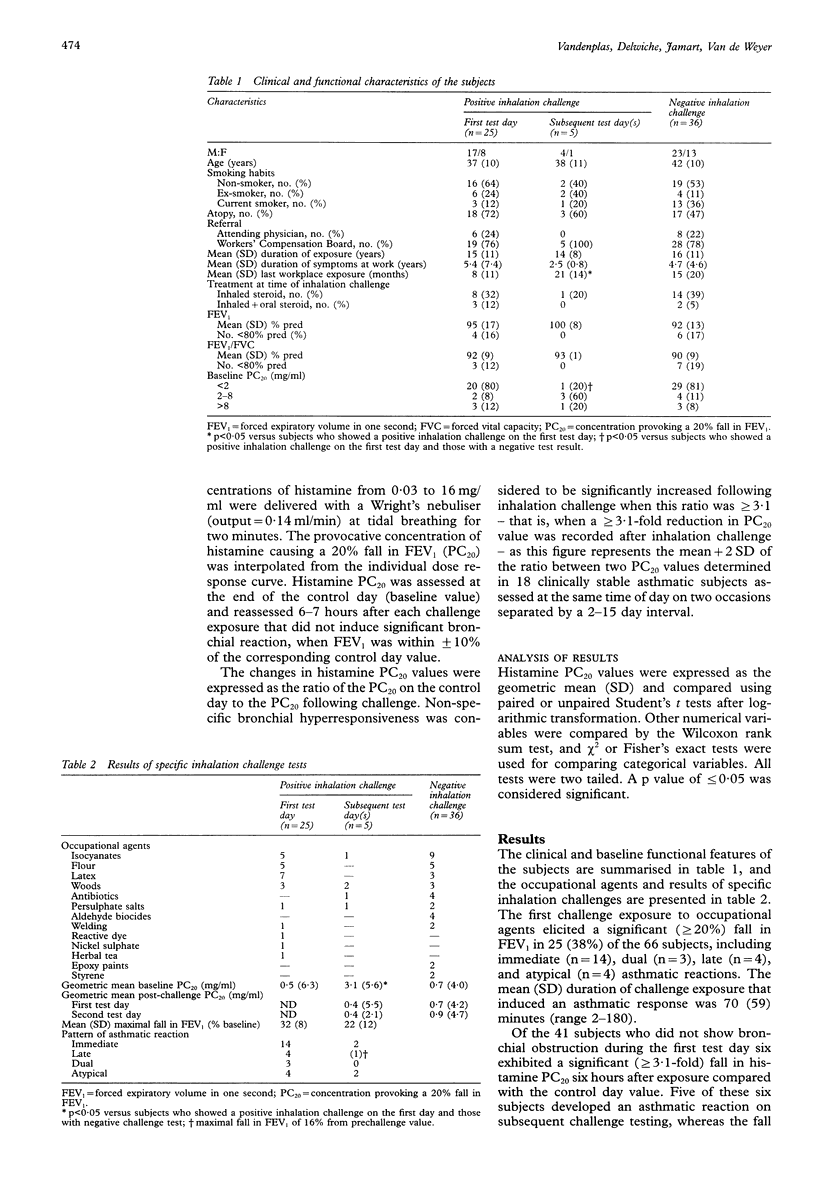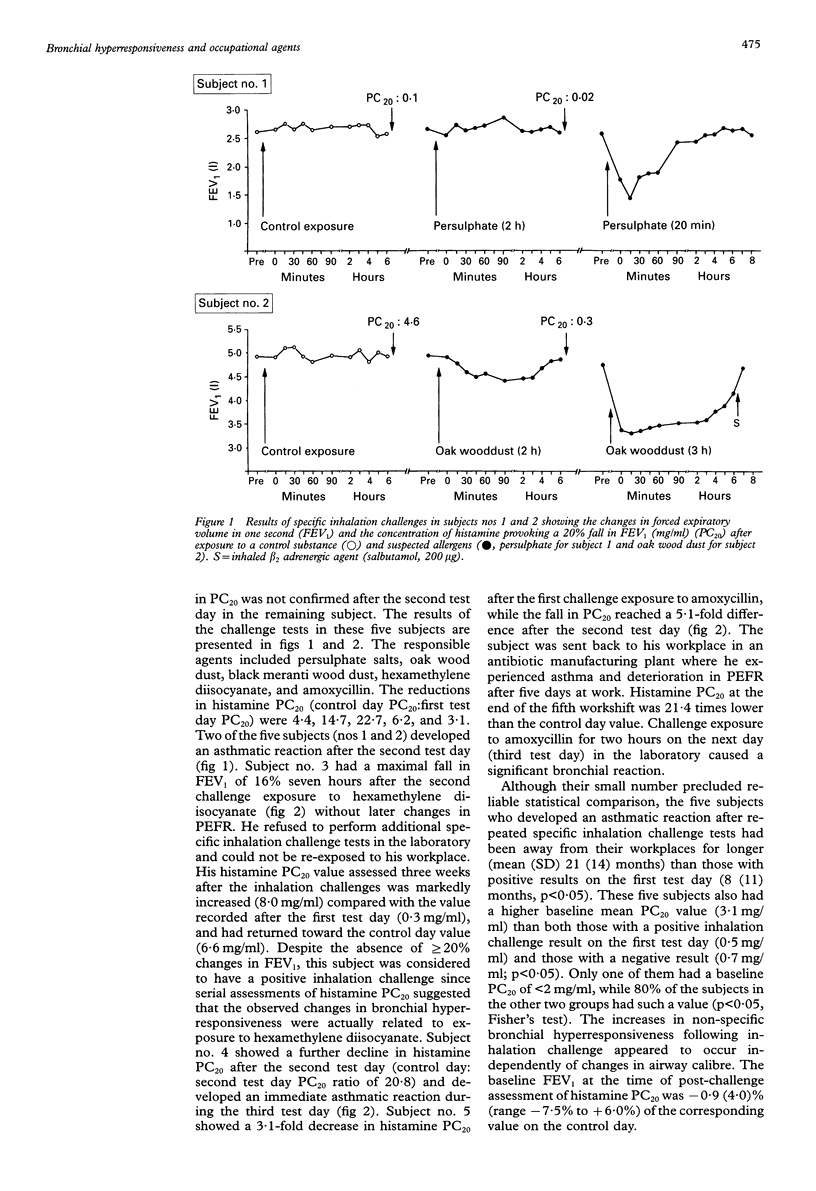Abstract
BACKGROUND: Specific bronchial reactivity to occupational agents may decline after exposure in the workplace ceases leading to falsely negative specific inhalation challenges. A study was carried out to assess prospectively whether increases in nonspecific bronchial hyperresponsiveness could be useful in detecting the bronchial response to occupational agents during specific inhalation challenges. METHODS: Specific inhalation challenges were performed in 66 subjects with possible occupational asthma due to various agents. After a control day the subjects were challenged with the suspected agent for up to two hours on the first test day. Those subjects who did not show an asthmatic reaction were rechallenged on the next day for 2-3 hours. The provocative concentration of histamine causing a 20% fall (PC20) in the forced expiratory volume in one second (FEV1) was assessed at the end of the control day as well as six hours after each challenge that did not cause a > or = 20% fall in FEV1. The subjects who had a significant (> or = 3.1-fold) reduction in PC20 value at the end of the second challenge day were requested to perform additional specific inhalation challenges. RESULTS: The first test day elicited an asthmatic reaction in 25 subjects. Of the other 41 subjects five (12%, 95% confidence interval (CI) 4% to 26%) exhibited a > or = 3.1-fold fall in the PC20 value after the inhalation challenge and developed an asthmatic reaction during the second (n = 3) or third (n = 2) challenge exposure. The offending agents included persulphate (n = 1), wood dust (n = 2), isocyanate (n = 1), or amoxycillin (n = 1). These five subjects had left their workplace for a longer period (mean (SD) 21 (14) months) than those who reacted after the first specific inhalation challenge (8 (11) months). CONCLUSIONS: The increase in non-specific bronchial hyperresponsiveness after a specific inhalation challenge can be an early and sensitive marker of bronchial response to occupational agents, especially in subjects removed from workplace exposure for a long time. Non-specific bronchial hyperresponsiveness should be systematically assessed after specific inhalation challenges in the absence of changes in airway calibre.
Full text
PDF






Selected References
These references are in PubMed. This may not be the complete list of references from this article.
- Banks D. E., Rando R. J. Recurrent asthma induced by toluene diisocyanate. Thorax. 1988 Aug;43(8):660–662. doi: 10.1136/thx.43.8.660. [DOI] [PMC free article] [PubMed] [Google Scholar]
- Banks D. E., Sastre J., Butcher B. T., Ellis E., Rando R. J., Barkman H. W., Jr, Hammad Y. Y., Glindmeyer H. W., Weill H. Role of inhalation challenge testing in the diagnosis of isocyanate-induced asthma. Chest. 1989 Feb;95(2):414–423. doi: 10.1378/chest.95.2.414. [DOI] [PubMed] [Google Scholar]
- Cartier A., Bernstein I. L., Burge P. S., Cohn J. R., Fabbri L. M., Hargreave F. E., Malo J. L., McKay R. T., Salvaggio J. E. Guidelines for bronchoprovocation on the investigation of occupational asthma. Report of the Subcommittee on Bronchoprovocation for Occupational Asthma. J Allergy Clin Immunol. 1989 Nov;84(5 Pt 2):823–829. doi: 10.1016/0091-6749(89)90346-1. [DOI] [PubMed] [Google Scholar]
- Cartier A. Definition and diagnosis of occupational asthma. Eur Respir J. 1994 Jan;7(1):153–160. doi: 10.1183/09031936.94.07010153. [DOI] [PubMed] [Google Scholar]
- Cartier A., L'Archevêque J., Malo J. L. Exposure to a sensitizing occupational agent can cause a long-lasting increase in bronchial responsiveness to histamine in the absence of significant changes in airway caliber. J Allergy Clin Immunol. 1986 Dec;78(6):1185–1189. doi: 10.1016/0091-6749(86)90270-8. [DOI] [PubMed] [Google Scholar]
- Cartier A., Malo J. L., Forest F., Lafrance M., Pineau L., St-Aubin J. J., Dubois J. Y. Occupational asthma in snow crab-processing workers. J Allergy Clin Immunol. 1984 Sep;74(3 Pt 1):261–269. doi: 10.1016/0091-6749(84)90256-2. [DOI] [PubMed] [Google Scholar]
- Cartier A., Thomson N. C., Frith P. A., Roberts R., Hargreave F. E. Allergen-induced increase in bronchial responsiveness to histamine: relationship to the late asthmatic response and change in airway caliber. J Allergy Clin Immunol. 1982 Sep;70(3):170–177. doi: 10.1016/0091-6749(82)90038-0. [DOI] [PubMed] [Google Scholar]
- Cloutier Y., Lagier F., Cartier A., Malo J. L. Validation of an exposure system to particles for the diagnosis of occupational asthma. Chest. 1992 Aug;102(2):402–407. doi: 10.1378/chest.102.2.402. [DOI] [PubMed] [Google Scholar]
- Cockcroft D. W., Killian D. N., Mellon J. J., Hargreave F. E. Bronchial reactivity to inhaled histamine: a method and clinical survey. Clin Allergy. 1977 May;7(3):235–243. doi: 10.1111/j.1365-2222.1977.tb01448.x. [DOI] [PubMed] [Google Scholar]
- Durham S. R., Graneek B. J., Hawkins R., Taylor A. J. The temporal relationship between increases in airway responsiveness to histamine and late asthmatic responses induced by occupational agents. J Allergy Clin Immunol. 1987 Feb;79(2):398–406. doi: 10.1016/0091-6749(87)90161-8. [DOI] [PubMed] [Google Scholar]
- Gannon P. F., Weir D. C., Robertson A. S., Burge P. S. Health, employment, and financial outcomes in workers with occupational asthma. Br J Ind Med. 1993 Jun;50(6):491–496. doi: 10.1136/oem.50.6.491. [DOI] [PMC free article] [PubMed] [Google Scholar]
- Hargreave F. E., Ramsdale E. H., Pugsley S. O. Occupational asthma without bronchial hyperresponsiveness. Am Rev Respir Dis. 1984 Sep;130(3):513–515. doi: 10.1164/arrd.1984.130.3.513. [DOI] [PubMed] [Google Scholar]
- Ihre E., Axelsson I. G., Zetterström O. Late asthmatic reactions and bronchial variability after challenge with low doses of allergen. Clin Allergy. 1988 Nov;18(6):557–567. doi: 10.1111/j.1365-2222.1988.tb02907.x. [DOI] [PubMed] [Google Scholar]
- Karol M. H., Tollerud D. J., Campbell T. P., Fabbri L., Maestrelli P., Saetta M., Mapp C. E. Predictive value of airways hyperresponsiveness and circulating IgE for identifying types of responses to toluene diisocyanate inhalation challenge. Am J Respir Crit Care Med. 1994 Mar;149(3 Pt 1):611–615. doi: 10.1164/ajrccm.149.3.8118626. [DOI] [PubMed] [Google Scholar]
- Malo J. L., Ghezzo H., L'Archevêque J., Cartier A. Late asthmatic reactions to occupational sensitizing agents: frequency of changes in nonspecific bronchial responsiveness and of response to inhaled beta 2-adrenergic agent. J Allergy Clin Immunol. 1990 May;85(5):834–842. doi: 10.1016/0091-6749(90)90065-c. [DOI] [PubMed] [Google Scholar]
- Mapp C. E., Boschetto P., Dal Vecchio L., Maestrelli P., Fabbri L. M. Occupational asthma due to isocyanates. Eur Respir J. 1988 Mar;1(3):273–279. [PubMed] [Google Scholar]
- Mapp C. E., Corona P. C., De Marzo N., Fabbri L. Persistent asthma due to isocyanates. A follow-up study of subjects with occupational asthma due to toluene diisocyanate (TDI). Am Rev Respir Dis. 1988 Jun;137(6):1326–1329. doi: 10.1164/ajrccm/137.6.1326. [DOI] [PubMed] [Google Scholar]
- Mapp C. E., Dal Vecchio L., Boschetto P., De Marzo N., Fabbri L. M. Toluene diisocyanate-induced asthma without airway hyperresponsiveness. Eur J Respir Dis. 1986 Feb;68(2):89–95. [PubMed] [Google Scholar]
- Mapp C. E., Polato R., Maestrelli P., Hendrick D. J., Fabbri L. M. Time course of the increase in airway responsiveness associated with late asthmatic reactions to toluene diisocyanate in sensitized subjects. J Allergy Clin Immunol. 1985 May;75(5):568–572. doi: 10.1016/0091-6749(85)90031-4. [DOI] [PubMed] [Google Scholar]
- Meredith S. K., Taylor V. M., McDonald J. C. Occupational respiratory disease in the United Kingdom 1989: a report to the British Thoracic Society and the Society of Occupational Medicine by the SWORD project group. Br J Ind Med. 1991 May;48(5):292–298. doi: 10.1136/oem.48.5.292. [DOI] [PMC free article] [PubMed] [Google Scholar]
- Moscato G., Dellabianca A., Vinci G., Candura S. M., Bossi M. C. Toluene diisocyanate-induced asthma: clinical findings and bronchial responsiveness studies in 113 exposed subjects with work-related respiratory symptoms. J Occup Med. 1991 Jun;33(6):720–725. doi: 10.1097/00043764-199106000-00014. [DOI] [PubMed] [Google Scholar]
- Paggiaro P. L., Vagaggini B., Dente F. L., Bacci E., Bancalari L., Carrara M., Di Franco A., Giannini D., Giuntini C. Bronchial hyperresponsiveness and toluene diisocyanate. Long-term change in sensitized asthmatic subjects. Chest. 1993 Apr;103(4):1123–1128. doi: 10.1378/chest.103.4.1123. [DOI] [PubMed] [Google Scholar]
- Pepys J., Hutchcroft B. J. Bronchial provocation tests in etiologic diagnosis and analysis of asthma. Am Rev Respir Dis. 1975 Dec;112(6):829–859. doi: 10.1164/arrd.1975.112.6.829. [DOI] [PubMed] [Google Scholar]
- Perrin B., Cartier A., Ghezzo H., Grammer L., Harris K., Chan H., Chan-Yeung M., Malo J. L. Reassessment of the temporal patterns of bronchial obstruction after exposure to occupational sensitizing agents. J Allergy Clin Immunol. 1991 Mar;87(3):630–639. doi: 10.1016/0091-6749(91)90381-w. [DOI] [PubMed] [Google Scholar]
- Stenton S. C., Avery A. J., Walters E. H., Hendrick D. J. Statistical approaches to the identification of late asthmatic reactions. Eur Respir J. 1994 Apr;7(4):806–812. doi: 10.1183/09031936.94.07040806. [DOI] [PubMed] [Google Scholar]
- Sterk P. J., Fabbri L. M., Quanjer P. H., Cockcroft D. W., O'Byrne P. M., Anderson S. D., Juniper E. F., Malo J. L. Airway responsiveness. Standardized challenge testing with pharmacological, physical and sensitizing stimuli in adults. Report Working Party Standardization of Lung Function Tests, European Community for Steel and Coal. Official Statement of the European Respiratory Society. Eur Respir J Suppl. 1993 Mar;16:53–83. [PubMed] [Google Scholar]
- Thorpe J. E., Steinberg D., Bernstein I. L., Murlas C. G. Bronchial reactivity increases soon after the immediate response in dual-responding asthmatic subjects. Chest. 1987 Jan;91(1):21–25. doi: 10.1378/chest.91.1.21. [DOI] [PubMed] [Google Scholar]
- Vandenplas O., Delwiche J. P., Evrard G., Aimont P., van der Brempt X., Jamart J., Delaunois L. Prevalence of occupational asthma due to latex among hospital personnel. Am J Respir Crit Care Med. 1995 Jan;151(1):54–60. doi: 10.1164/ajrccm.151.1.7812572. [DOI] [PubMed] [Google Scholar]
- Vandenplas O., Malo J. L., Saetta M., Mapp C. E., Fabbri L. M. Occupational asthma and extrinsic alveolitis due to isocyanates: current status and perspectives. Br J Ind Med. 1993 Mar;50(3):213–228. doi: 10.1136/oem.50.3.213. [DOI] [PMC free article] [PubMed] [Google Scholar]
- Venables K. M., Davison A. G., Newman Taylor A. J. Consequences of occupational asthma. Respir Med. 1989 Sep;83(5):437–440. doi: 10.1016/s0954-6111(89)80078-2. [DOI] [PubMed] [Google Scholar]


